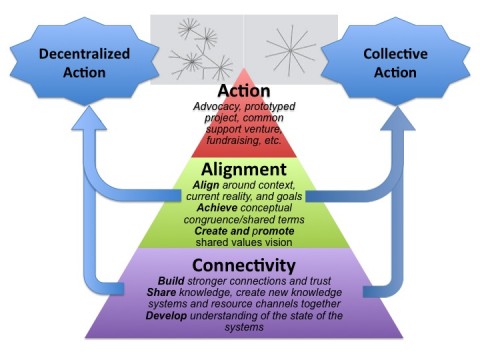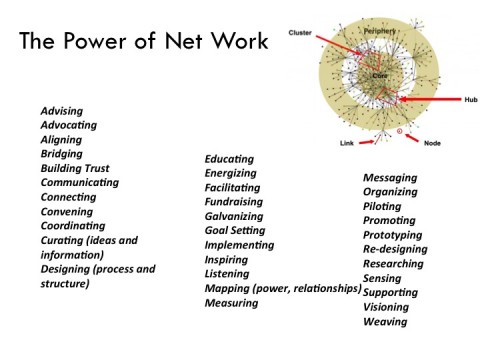What is Network Strategy?
October 22, 2014 Leave a comment The above graphic is something that I recently created, borrowing heavily from the good work of Peter Plastrik and Madeleine Taylor, to help convey what is meant by engaging in “network strategy.” One of the challenges we’ve encountered in working with different networks is helping people to understand the difference between strategy development and network development. I try to meet this challenge, in part, by showing how they are not so different, or at least, that they are intimately connected. The diagram is also designed to help people get beyond some of the either/or thinking that we encounter. For example, it’s not that we have to choose between decentralized self-organized action and more formally coordinated collective action. It can be both!
The above graphic is something that I recently created, borrowing heavily from the good work of Peter Plastrik and Madeleine Taylor, to help convey what is meant by engaging in “network strategy.” One of the challenges we’ve encountered in working with different networks is helping people to understand the difference between strategy development and network development. I try to meet this challenge, in part, by showing how they are not so different, or at least, that they are intimately connected. The diagram is also designed to help people get beyond some of the either/or thinking that we encounter. For example, it’s not that we have to choose between decentralized self-organized action and more formally coordinated collective action. It can be both!
So here’s what the graphic is meant to convey. First of all, network strategy is grounded at a fundamental level in creating (strategic) connectivity, by building linkages and trust between key stakeholders and perhaps unusual bedfellows. This can be done by convening people; sharing stories, data and other forms of information; co-creating knowledge; learning together, etc. Part of the value of this connectivity is that it can lead to orthogonal thinking and bolster individual network participants’ efforts in the shared domain where the network is focused. What also may ensue is self-organized action between those who are meeting one another for the first time or getting to know one another better (see the arrow to the left side of the triangle). This is all well and good and is something that networks should try to track.
”Healthy networks measure their impact, in particular by establishing the links between decentralized network action and outcomes.”
Up a level, networks may be compelled to create some kind of shared value proposition in the form of a shared vision, values, charter, statement around (systemic) commitment and/or context, etc. This can provide additional value to individual participants and “two-sie or three-sie” self-organized efforts, as they are more prone to head in the same general direction or with some kind of deeper shared understanding of context.
And then there are those instances when a network is called to some form of collective action, such as advocacy, a communications campaign, fundraising, or some other joint venture. This can happen even as smaller self-organized action continues at the so-called periphery of the network, and really most collective action should be about creating the conditions for those self-organized efforts (which is what is meant by “making the periphery the norm” in network building lingo).
Something else I hope the diagram helps with as we walk it through is the myriad forms of action (see below) a network can engage in and how these can build on one another to ultimately achieve “net impact.”
